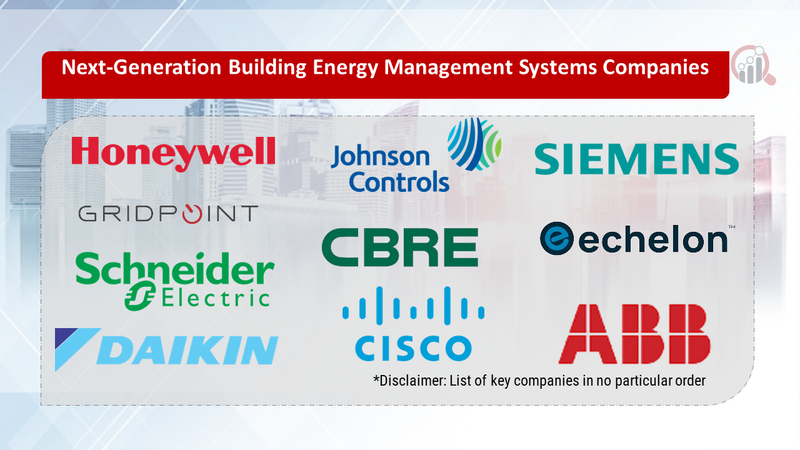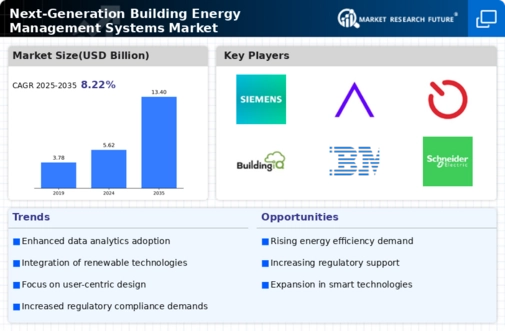Top Industry Leaders in the Next Generation Building Energy Management Systems Market

Next-Generation Building Energy Management Systems Market: A Competitive Powerhouse Fueled by Efficiency
The Next-Generation Building Energy Management Systems market is electrifying the future of building energy management. Driven by sustainability goals, skyrocketing energy costs, and technological advancements, this market is a fierce battleground for established players and innovative startups alike. Navigating this dynamic landscape requires a clear understanding of the key players, their strategies, and the factors fueling the competitive fire.
Key Players:
- Honeywell
- Johnson Controls
- Schneider Electric
- Siemens
- ABB
- CBRE Group
- CISCO
- Daikin
- Echelon,
- GridPoint
Strategies for Domination:
-
Holistic Solutions: Offering comprehensive NG-BEMS solutions encompassing hardware, software, and services across the entire building energy ecosystem attracts more customers seeking seamless integration. -
Data-Driven Optimization: Leveraging big data analytics, AI, and machine learning to optimize energy consumption, predict maintenance needs, and personalize building operation is a crucial differentiator. -
Cybersecurity Fortification: Building robust cybersecurity features into NG-BEMS platforms and services addresses growing concerns about data breaches and cyberattacks in smart buildings. -
Openness and Interoperability: Embracing open standards and ensuring interoperability with existing building systems expands compatibility and fosters customer loyalty.
Factors for Market Share Analysis:
-
Product Portfolio Breadth: Offering a wide range of NG-BEMS solutions that cater to diverse building types and sizes attracts various customer segments. -
Regional Presence and Partnerships: Having a strong global presence and strategic partnerships with local providers and system integrators expands market reach. -
Innovation and Technological Advancements: Continuously investing in research and development to deliver cutting-edge features like edge computing, predictive maintenance, and demand response capabilities creates a competitive edge. -
Pricing and Customer Support: Competitive pricing strategies and exceptional customer support foster brand loyalty and drive market share growth.
New and Emerging Players:
-
Startups: Nimble startups like Enlighted, GridBeyond, and EnerNOC are challenging established players with innovative NG-BEMS solutions focused on energy microgrids, demand response optimization, and distributed energy resources management. -
PropTech Companies: PropTech companies like Open Buildings and BuildingOS are disrupting the market with digital twin technology and cloud-based platforms that offer real-time building data visualization and advanced analytics. -
IoT and Sensor Specialists: Companies like Canary Labs and Sense Labs are contributing to the market with smart sensors and IoT devices that provide granular energy data and enable granular control over building systems.
Current Company Investment Trends:
-
Artificial Intelligence (AI) and Machine Learning (ML): Investments in AI and ML for energy forecasting, anomaly detection, and self-learning optimization algorithms are revolutionizing building energy management. -
Cloud-Based Platforms: Shifting towards cloud-based NG-BEMS platforms unlocks scalability, data accessibility, and remote management capabilities, attracting new customers. -
Cybersecurity Integration: With increasing cybersecurity threats, companies are investing in advanced security features and protocols to protect building systems and data. -
Integration with Smart Cities: NG-BEMS are increasingly being integrated with smart city initiatives to optimize energy grids, manage peak demand, and contribute to sustainable urban development.
The Future Grid:
The NG-BEMS market is poised for continued exponential growth, driven by stringent sustainability regulations, rising energy costs, and advancements in AI and IoT technologies. Understanding the competitive landscape, key players' strategies, and emerging trends will be crucial for businesses and investors to capitalize on the vast opportunities and navigate the complex dynamics of this electrifying market.
Latest Company Updates:
-
Cybersecurity concerns: Increased connectivity raises concerns about data breaches and cyberattacks on BEMS, requiring robust security measures. (Jan 17, 2024) -
Integration complexity: Integrating various BEMS components and data can be complex, requiring expertise and specialized skills. (Jan 13, 2024) -
Talent gap: A shortage of skilled professionals trained in BEMS technologies hinders widespread adoption and optimal system utilization. (Jan 8, 2024)










